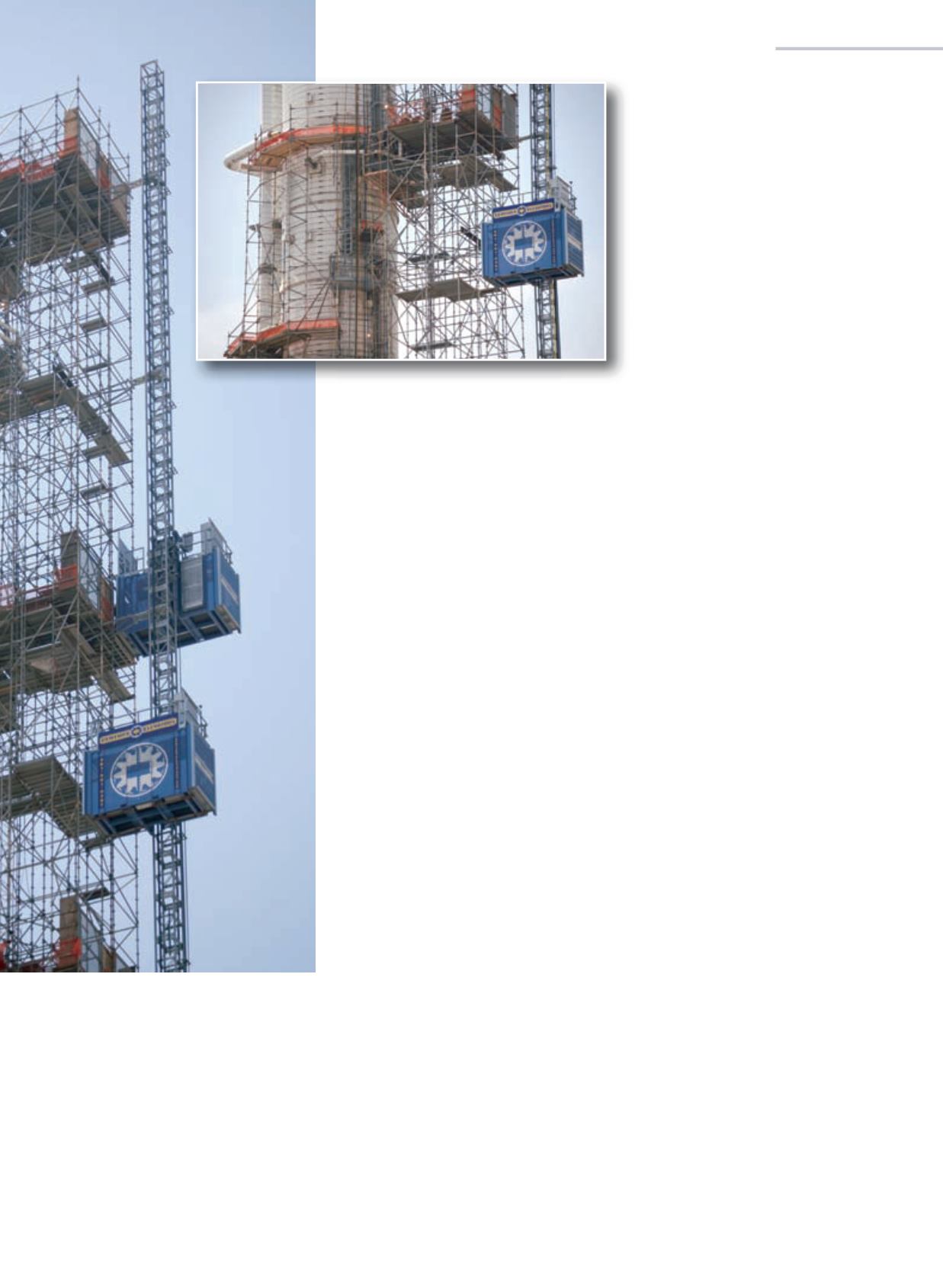
650 Twin. The benefits of this construction hoist
were clear to see, Schmidt said. The hoist had
a lifting speed of 213 feet/min with a maximum
lifting height of 1,312 feet. A total of up to 30
people or an overall material weight of 7,054
pounds could be transported on the 5 foot by
13.1 foot platform.
A PH double car was used on the BASF
steam cracker. That meant that two cars – one
on the left and one on the right side of the
mast – could travel upward and downward
independently of each other.
“The scaffolding and lift must be attuned to
each other with great precision and therefore
the scaffolding was specifically strengthened to
withstand the anchoring forces of the lift with
its two cars,” Schmidt said.
Although most of the maintenance work
was to be completed before the start of the
hurricane season, the scaffolding and lift mast
had to be designed to resist hurricane-style
wind gusts. Since the Gulf of Mexico is one of
the world’s most hurricane-affected regions,
the PH 3240 650 Twin was also equipped with
a special wind gauge.
Safety was paramount, Schmidt said. Before
each shift, the car, mast and anchorage were
inspected and approved for use. Racks, pinions,
gates, doors, limit switches, brakes and other
electrical and mechanical components were
also checked to ensure the safe and precise
operation of the lift.
Two machine operators and two technicians
were on-site 24 hours a day for the duration of
the work.
More session highlights
Chris Sleight, editor of KHL Group’s
International Construction
, spoke on behalf of
the International Council about construction
markets around the world. Sleight said world
economic growth for the Americas in 2013 was
as follows: U.S. 2.2 percent and Latin America,
3.2 percent. World growth is expected to be
around 3.9 percent.
Sleight said economic growth will remain
lower than in boom years but emerging markets
will see growth. In the U.S., construction
markets are seeing a recovery after the long
recession. The private sector is driving growth
while the public sector has fallen. He also noted
that housing starts are still weak. For Latin
America, Brazil continues to dominate with the
World Cup and Olympics fueling construction.
Smaller markets, such as Chile, Panama and
Peru are also strong. There are many good
long-term prospects, Sleight said.
Stephen Pike of ScaffoldNation presented
“Tweet this! Engaging a 5,000-year-old
industry in 140 characters or less” about social
media in the workplace. Pike discussed how
organizations will survive - and thrive – if they
embrace technologies and develop their own
corporate “brands” in the industry. Pike was
a big supporter of YouTube, where companies
and people alike can post videos about virtually
anything. Pike explored the challenges of
engaging a mobile, agile and (sometimes)
hostile scaffolding workforce in 2013, as well as
the struggle to connect with media-swamped
customers in the age of status updates and
Twitter feeds. In the end, Pike encouraged
everyone to be active on social media.
The Occupational Safety & Health
Administration gave an update on its fall
prevention campaign. In 2010, OSHA
recorded 264 fall fatalities (255 were falls to
a lower level) out of the 774 total fatalities in
construction. This figure calls for improving fall
prevention techniques. To prevent falls from
scaffolds and aerial lifts, OSHA explained the
agency’s new fall prevention campaign. This
nationwide outreach program will focus on
ladders, scaffolds and aerial lifts by providing
literature and steps on how to plan ahead to get
the job done safely, with the right equipment
and how train everyone to use the equipment
correctly.
According to the session, planning includes
deciding how the job will be done, what tasks
will be involved and what safety equipment may
be needed to complete each task. Providing
the right planning is about protecting workers
by providing fall protection and the right
equipment for jobs that require workers who
are at risk for serious injury or death if they
should fall. Finally, falls can be prevented when
workers understand proper setup and safe
use of equipment, so they need training on the
specific equipment they will use to complete
the job. Employers must train workers in
hazard recognition and in the care and safe use
ladders, scaffolds, fall protection systems, and
other equipment they’ll be using on the job.
The Plank & Platform Council had Ali
Hajighafouri from Avontus Software talk about
how scaffold management software can help
clients and improve efficiency. As scaffolding
business picks up again, existing companies
are working hard to expand their share of the
market and new players are looking to establish
their presence. Maintaining a competitive edge
is becoming more important than ever, he said.
“You could lower prices and expand your
inventory and services but to come out ahead
while keeping your overhead down, you need
an innovative approach,” Hajighafouri said.
“Today’s software programs can set you apart
from the competition in several ways.”
Hajighafouri explained how scaffolding
companies gain an advantage by using software
to respond to estimate requests more quickly
and more professionally, while accurate
inventory tracking and rental billing make
The scaffolding and lift must be attuned to
each other with great precision and therefore
the scaffolding was specifically strengthened
to withstand the anchoring forces of the lift
with its two cars.
BASF
commissioned
Houston company
Century Elevators
to provide a
construction hoist,
which was a GEDA
PH 3240 650 Twin.
SAIA REVIEW
39
SEPTEMBER-OCTOBER 2013
ACCESS, LIFT & HANDLERS


